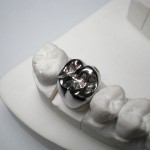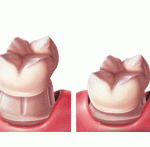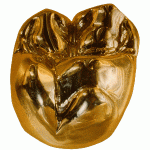
A metal tooth cap
Dental caps in general add a good deal of strength to a weakened or worn tooth, and if all conditions are favourable, a good tooth cap can last ten to fifteen years. Depending on your habits and the condition of your gums, there may be some drawbacks or benefits for you. Your dentist will advise which is best for you given several factors, such as how important appearance is to you. A tooth cap, also known as a dental crown, is a covering placed over a tooth and cemented into place. Materials used to make tooth caps include metal, resin, porcelain, or a combination of ceramic and metal.
How is a tooth prepared for a tooth cap?
Regardless of which material will be used to fabricate the tooth cap, the procedure to prepared the tooth which is receiving the tooth cap is the same. If the tooth is not root canal treated (in other words, it is a vital tooth), local anaesthesia will be given to the patient to numb that particular tooth. This is because the procedure will be involving in removing the tooth structure, and this can cause much sensitivity for the patient with vital tooth. All non-vital tooth must be root canal treated, and all dental caries must be removed prior to preparing the tooth for a tooth cap. Other than that, x rays must be taken for diagnostic purposes, as there are a few factors that can influence the success of a tooth cap.
After anaesthesia, the tooth structure will be removed from the tooth which is receiving the tooth cap using a special set of burs. Depending on the material that will be used to fabricate the tooth cap, different amount of tooth structure will be removed. For metal tooth caps, at least 1mm will be removed from the top of the tooth (also known as the occlusal side), and 1.5 mm to 1.9 mm of tooth structure will be removed from the sides of the tooth.
After the preparation, a temporary tooth cap will be given to the patient for various purposes, and it is important for the patient to notify the dentist if the temporary tooth cap falls out at any moment.
1. Visibility
A metal tooth cap is composed entirely of a metal alloy. In comparison to tooth-colored porcelain or resin, metal tooth caps are quite obviously visible. This is a disadvantage if you want your capped tooth to match your other teeth. Visibility is more of a concern when the teeth in the front of the mouth are capped with metal. If the teeth in the back of your mouth are metal-capped, they are unlikely to be seen unless you open your mouth widely.
2. Temperature Sensitivity
Metals in general are efficient conductors of heat. This means that metal tooth caps may conduct heat or cold from food or the environment into your tooth. Those with sensitive teeth may find that metal caps are more temperature sensitive–for example, to hot coffee–than porcelain or resin caps.
3. Cost
There are two types of metal – precious alloy, which contains some amount gold or white gold, and non-precious alloy, which does not contain either gold or white gold at all. Although other metals may be used for tooth caps, gold is a common metal for the construction of these caps. The malleability of gold makes it popular with dentists as they can achieve a snug and precise fit of the gold tooth cap to the tooth. However, gold is an expensive metal and, therefore, the cost of a gold tooth cap may be a disadvantage when compared to ceramic or resin materials.
The actual gold content can range from 90% to as low as 5%. Gold in its pure state is too soft to withstand the rigors of functioning in the mouth, therefore, platinum or palladium are frequently added to harden the gold. There are some disadvantages when this is done. Firstly, both of these materials raise the already high melting point of the alloy. Secondly, platinum is expensive, while palladium has been outlawed in some countries because it is toxic, and both turn the gold color to silver. Copper can be added to restore the gold color, but it has a reddish tint, is toxic, and forms bubbles in the alloy.
While the metal tooth cap has its disadvantages, it also offers some benefits not found with other tooth caps. A metal crown is more durable than ceramic or porcelain, is not prone to tooth-chipping, doesn’t wear down quickly and is the least abrasive cap to the teeth near it. In general, tooth caps are considered as an invasive procedure as it involves cutting away healthy tooth structure. However, the amount of tooth substances that needs to be removed is also considerably less than tooth caps made out of other materials, so it is a more conservative procedure. Metal tooth caps are often recommended for molars in the back of the mouth where they’re not likely to be seen.

